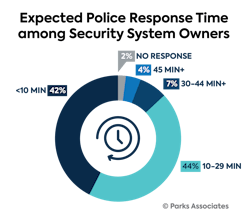The Smart Money: Deep Dive on the False Alarm Issue
This article originally appeared in the May 2024 issue of Security Business magazine. Don’t forget to mention Security Business magazine on LinkedIn and @SecBusinessMag on Twitter if you share it.
Police response times face challenges due to limited resources, staffing shortages, and high call volumes – particularly in expansive or high-crime areas where officers are spread thin. Calls are prioritized by severity, meaning less urgent incidents may see significant delays, and non-emergency calls can congest the system, delaying responses to more critical situations.
Consumers who invest in professional monitoring services for their security systems do so with the expectation of rapid and reliable response in life-threatening situations; in fact, 87% of security owners say reliable and fast response to security events was important to their system purchase decision, according to Parks Associates.
This expectation is not just about the quick and reliable arrival of police, fire, or medical teams, but also about the assurance of safety and security in the most critical moments. At the same time, security providers are challenged to prove their value against new entrants offering self-monitoring solutions that are “safe enough” for many consumers. Providers seek new offerings that can differentiate from self-monitoring, create tiers of value-added services, and drive new revenues.
Rapid and Reliable Response
Current emergency response times and the police environment underscore the urgency for more efficient resource allocation, enhanced staffing strategies, and better call management and prioritization systems to ensure timely responses. Public responders increasingly seek solutions that can help – moving away from traditional service models in favor of instant, digital alternatives, and with real-time information.
Residential security players are supporting overwhelmed public resources with new standards – such as The Monitoring Association’s AVS-01 alarm scoring standard – innovative verification technologies, and advanced monitoring and private guard services that help provide more context to alarms. All ecosystem players must innovate and experiment with new models to ensure priority alarms get a quick response.
Consumer Expectations for Police Response
Traditional alarm systems market the value of having 24/7 call center support in an emergency. Accordingly, consumers expect a fast response from first responders during an alarm event – notably, 86% of alarm system owners expect a response within half an hour, and 42% expect a police response within 10 minutes of an alarm.
Actual police response times can be much longer than consumers expect. While there are no standardized databases to record police response, law enforcement data analyst Jeff Asher’s analysis of 15 municipalities that share calls for service data shows a worrying trend, with all but one city showing an increase in response times between 2019 and 2022. Response times increased over 10% in six of the municipalities between 2019 and 2022, with response times across those same municipalities ranging from 78 minutes to 146 minutes.
The longer response times are not just limited to these municipalities; anecdotal data from media reports indicates that this is a nationwide issue:
- A review of police response in San Diego from 2009 to 2022 found drastically increased times, as a record 230 San Diego police officers left the department in fiscal 2021-2022.
- Denver police response times to calls involving an imminent threat to life increased from 11 minutes, 37 seconds in 2018 to 14 minutes, 38 seconds in 2022. Response to quality-of-life and property issues increased from 28 minutes, 52 seconds to 34 minutes, 25 seconds in the same timeframe.
Longer response times are impacting police response across all priority levels, as fewer police officers combined with an increased rate of calls for service take their toll.
Most alarm events are false, and fines from municipalities are becoming more common. Parks Associates research from Q2 2021 shows about 62% of security system owners experience a false alarm each year, and two in three of them will pay a fine for them; however, in Q4 2023, a quarter of respondents do not believe they will get fined for too many false alarms, and a further 43% are unsure. These findings indicate that consumers are largely unaware of the realities of law enforcement response today and their personal liability for fees and fines should too many false alarms occur.
Should customers become aware of the realities of police response – and the role of false alarms in alarm response de-prioritization – it could lead to a cord-cutting moment for the security industry.
Those with professional monitoring have higher expectations of quick police response to an emergency than those without pro-monitoring, by a wide margin. This lack of knowledge also extends to the burden placed on law enforcement, as pro-monitored households are no more likely than other security system owners to feel their security system triggers too many false alarms.
Police Response Changes a Growing Concern
As a result of false alarms, municipalities are changing the way they handle calls for service, ranging from alternative methods of engagement to narrowing the scope of what merits a response:
- DALLAS: The police department has shifted to online reporting for several crimes classified as non-emergencies, which, while not targeted at alarms at this time, could be expanded to include such calls for service in the future.
- LAS VEGAS: The Las Vegas Metropolitan Police Department’s policy is to only broadcast that an alarm has been tripped, and by default, no officer is dispatched. Officers may respond at their discretion.
- MILWAUKEE: The city of Milwaukee enacted an ordinance that requires a private security guard dispatched to the alarm location by the security company to verify a legitimate crime is in progress or has occurred, and only then may a police officer be dispatched.
As consumers become more aware of these changes and savvier about the gap between the service they expect and the service they will receive, the risk to the security industry’s reputation and market capture increases.
Proactive Solutions and New Thinking
The relationship between customer loyalty and confidence in emergency services underscores the value of dependable security solutions and the role they play in the broader ecosystem of public safety. This points to an opportunity for security service companies to reinforce their customer relationships and enhance their value proposition by offering reliable products and building on the trust customers place in their local first responders.
This same dynamic highlights a critical risk for the security industry – Parks Associates research indicates that system owners are largely unaware of the problem of alarm de-prioritization among law enforcement due to false alarms. Instead, they incorrectly assume that a professionally monitored system will result in faster response. Should these customers become aware of the realities of police response – and the role of false alarms in alarm response de-prioritization – it could lead to a cord-cutting moment for the security industry.
Looking ahead, there's an opportunity for security companies to explore new business models that could include services like private guards for added protection and reassurance. This is a path to differentiation in a competitive market, while addressing the evolving needs and concerns of customers.
Daniel Holcomb is Senior Analyst of Smart Home Research for market research and consulting firm Parks Associates. Elizabeth Parks and Jennifer Kent also contributed to this article. This article is an excerpt from Parks Associates' white paper, Expectations vs. Reality: Enhancing Alarm Monitoring Response, published in partnership with RSPNDR (https://online.flippingbook.com/view/875906886).
About the Author

Daniel Holcomb
Daniel Holcomb is Senior Analyst for Parks Associates, which covers the security and smart home market extensively within its research practice. The company will host the 20th annual CONNECTIONS SUMMIT at CES Jan. 7, 2026, and the 30th annual CONNECTIONS, The Premier Connected Home Conference, on May 5-7 in Santa Clara, Calif. Visit www.parksassociates.com to learn more.


